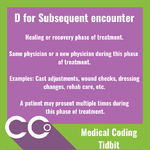Many codes in Chapter 19 of ICD-10-CM (Injury, Poisoning, and Certain Other Consequences of External Causes (S00-T88)) require a 7th character to identify the episode of care. With the exception of the fracture codes, most Chapter 19 codes have three 7th character values.
A seventh character “D” is appropriate during the recovery phase, no matter how many times he has seen the provider for this problem, previously.
Note that ICD-10-CM guidelines do not definitively establish when “active treatment” becomes “routine care.” Active treatment occurs when the provider sees the patient and develops a plan of care. When the patient is following the plan, that is subsequent. If the provider needs to adjust the plan of care—for example, if the patient has a setback or must returns to the OR—the care becomes active, again.
Subsequent Encounter:
• 7th character “D” subsequent encounter is used for encounters after the patient has received active treatment of the condition and is receiving routine care for the condition during the healing or recovery phase. Examples of subsequent care are: cast change or removal, an x-ray to check healing status of fracture, removal of external or internal fixation device, medication adjustment, other aftercare and follow up visits following treatment of the injury or condition
• Fractures are coded using the appropriate 7th character for subsequent care for encounters after the patient has completed active treatment of the fracture and is receiving routine care for the fracture during the healing or recovery phase
• Care of complications of fractures, such as malunion and nonunion, should be reported with the appropriate 7th character for subsequent care with nonunion (K, M, N,) or subsequent care with malunion (P, Q, R).
A subsequent encounter (character “D”) describes an episode of care during which the patient receives routine care for her or his condition during the healing or recovery phase. Examples include cast change or removal, medication adjustment, and other follow-up visits following treatment of the injury or condition.
Note that ICD-10-CM guidelines do not definitively establish when “active treatment” becomes “routine care.” This is a clinical decision based on the individual’s course of treatment. As Rhonda Buckholtz, AAPC Vice President of Strategic Development, explains, “When the doctor sees the patient and develops his plan of care—that is active treatment. When the patient is following the plan—that is subsequent. If the doctor needs to adjust the plan of care—for example, if the patient has a setback or must returns to the OR—the care becomes active, again.”
A seventh character “D” is appropriate during the recovery phase, no matter how many times he has seen the provider for this problem previously.


 www.aapc.com
www.aapc.com

Subsequent Indicates Recovery
ICD-10-CM defines subsequent encounters as “encounters after the patient has received active treatment of the injury and is receiving routine care for the injury during the healing or recovery phase. Examples of subsequent care are: cast change or removal, removal of external or internal fixation device, medication adjustment, other aftercare and follow up visits following injury treatment.”A seventh character “D” is appropriate during the recovery phase, no matter how many times he has seen the provider for this problem, previously.
Note that ICD-10-CM guidelines do not definitively establish when “active treatment” becomes “routine care.” Active treatment occurs when the provider sees the patient and develops a plan of care. When the patient is following the plan, that is subsequent. If the provider needs to adjust the plan of care—for example, if the patient has a setback or must returns to the OR—the care becomes active, again.
Subsequent Encounter:
• 7th character “D” subsequent encounter is used for encounters after the patient has received active treatment of the condition and is receiving routine care for the condition during the healing or recovery phase. Examples of subsequent care are: cast change or removal, an x-ray to check healing status of fracture, removal of external or internal fixation device, medication adjustment, other aftercare and follow up visits following treatment of the injury or condition
• Fractures are coded using the appropriate 7th character for subsequent care for encounters after the patient has completed active treatment of the fracture and is receiving routine care for the fracture during the healing or recovery phase
• Care of complications of fractures, such as malunion and nonunion, should be reported with the appropriate 7th character for subsequent care with nonunion (K, M, N,) or subsequent care with malunion (P, Q, R).
A subsequent encounter (character “D”) describes an episode of care during which the patient receives routine care for her or his condition during the healing or recovery phase. Examples include cast change or removal, medication adjustment, and other follow-up visits following treatment of the injury or condition.
Note that ICD-10-CM guidelines do not definitively establish when “active treatment” becomes “routine care.” This is a clinical decision based on the individual’s course of treatment. As Rhonda Buckholtz, AAPC Vice President of Strategic Development, explains, “When the doctor sees the patient and develops his plan of care—that is active treatment. When the patient is following the plan—that is subsequent. If the doctor needs to adjust the plan of care—for example, if the patient has a setback or must returns to the OR—the care becomes active, again.”
A seventh character “D” is appropriate during the recovery phase, no matter how many times he has seen the provider for this problem previously.
Coding Corner: “Initial” vs. “subsequent” vs. “sequela” in ICD-10-CM coding
CPR’s “Coding Corner” focuses on coding, compliance and documentation issues relating specifically to physician billing. This month’s tip comes from G. John Verhovshek, the managing editor for AAPC...
www.cmadocs.org

When Is an Injury Initial, Subsequent, or Sequela?
Many injury codes in Chapter 19 of ICD-10-CM require a 7th character to identify the episode of care: initial, subsequent, or sequela.



